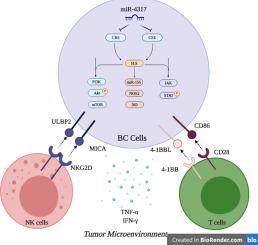Journal of Advanced Research ( IF 10.7 ) Pub Date : 2020-07-16 , DOI: 10.1016/j.jare.2020.07.006 Rana Ahmed Youness 1 , Ahmed Zakaria Gad 2, 3, 4, 5 , Khaled Sanber 3, 4, 6 , Yong Jin Ahn 7, 8 , Gi-Ja Lee 7, 8 , Emad Khallaf 9 , Hafez Mohamed Hafez 9 , Amira Abdel Motaal 10, 11 , Nabil Ahmed 2, 3, 4, 5, 12 , Mohamed Zakaria Gad 13

|
Introduction
Hydrogen sulphide (H2S) has been established as a key member of the gasotransmitters family that recently showed a pivotal role in various pathological conditions including cancer.
Objectives
This study investigated the role of H2S in breast cancer (BC) pathogenesis, on BC immune recognition capacity and the consequence of targeting H2S using non-coding RNAs.
Methods
Eighty BC patients have been recruited for the study. BC cell lines were cultured and transfected using validated oligonucleotide delivery system. Gene and protein expression analysis was performed using qRT-PCR, western blot and flow-cytometry. In-vitro analysis for BC hallmarks was performed using MTT, BrdU, Modified Boyden chamber, migration and colony forming assays. H2S and nitric oxide (NO) levels were measured spectrophotometrically. Primary natural killer cells (NK cells) and T cell isolation and chimeric antigen receptor transduction (CAR T cells) were performed using appropriate kits. NK and T cells cytotoxicity was measured. Finally, computational target prediction analysis and binding confirmation analyses were performed using different software and dual luciferase assay kit, respectively.
Results
The H2S synthesizing enzymes, cystathionine β-synthase (CBS) and cystathionine γ-lyase (CSE), exhibited elevated levels in the clinical samples that correlated with tumor proliferation index. Knock-down of CBS and CSE in the HER2+ BC and triple negative BC (TNBC) cells resulted in significant attenuation of BC malignancy. In addition to increased susceptibility of HER2+ BC and TNBC to the cytotoxic activity of HER2 targeting CAR T cells and NK cells, respectively. Transcriptomic and phosphoprotein analysis revealed that H2S signaling is mediated through Akt in MCF7, STAT3 in MDA-MB-231 and miR-155/ NOS2/NO signaling in both cell lines. Lastly, miR-4317 was found to function as an upstream regulator of CBS and CSE synergistically abrogates the malignancy of BC cells.
Conclusion
These findings demonstrate the potential role of H2S signaling in BC pathogenesis and the potential of its targeting for disease mitigation.
中文翻译:

靶向治疗乳腺癌中的硫化氢信号
介绍
硫化氢 (H 2 S) 已被确定为气体递质家族的关键成员,该家族最近在包括癌症在内的各种病理状况中显示出关键作用。
目标
本研究调查了 H 2 S 在乳腺癌 (BC) 发病机制中的作用、对 BC 免疫识别能力的作用以及使用非编码 RNA靶向 H 2 S 的后果。
方法
该研究招募了 80 名 BC 患者。使用经过验证的寡核苷酸递送系统培养和转染 BC 细胞系。使用qRT-PCR、蛋白质印迹和流式细胞术进行基因和蛋白质表达分析。使用 MTT、BrdU、改良的 Boyden 室、迁移和菌落形成测定对 BC 标志进行体外分析。H 2用分光光度法测量 S 和一氧化氮 (NO) 水平。使用适当的试剂盒进行原代自然杀伤细胞(NK 细胞)和 T 细胞分离和嵌合抗原受体转导(CAR T 细胞)。测量 NK 和 T 细胞的细胞毒性。最后,分别使用不同的软件和双荧光素酶检测试剂盒进行计算靶点预测分析和结合确认分析。
结果
H 2 S 合成酶、胱硫醚 β-合酶 (CBS) 和胱硫醚 γ-裂解酶 (CSE) 在与肿瘤增殖指数相关的临床样本中表现出升高的水平。敲除 HER2+ BC 和三阴性 BC (TNBC) 细胞中的 CBS 和 CSE 导致 BC 恶性肿瘤显着减弱。除了增加 HER2+ BC 和 TNBC 对分别靶向 CAR T 细胞和 NK 细胞的 HER2 的细胞毒活性的敏感性。转录组学和磷蛋白分析表明,H 2 S 信号传导是通过 MCF7 中的 Akt、MDA-MB-231 中的 STAT3 和两种细胞系中的 miR-155/NOS2/NO 信号传导来介导的。最后,发现 miR-4317 作为 CBS 的上游调节剂起作用,CSE 协同消除 BC 细胞的恶性。
结论
这些发现证明了 H 2 S 信号传导在 BC 发病机制中的潜在作用及其靶向缓解疾病的潜力。


























 京公网安备 11010802027423号
京公网安备 11010802027423号